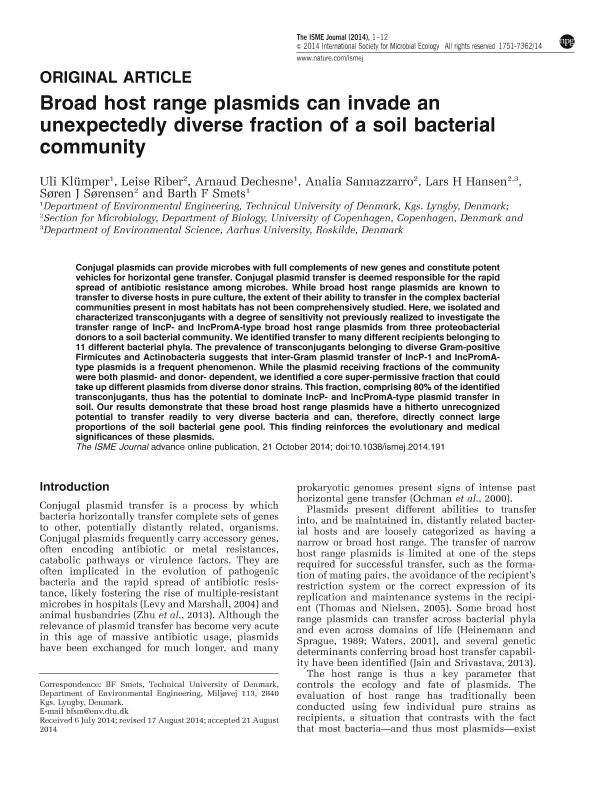Mostrar el registro sencillo del ítem
dc.contributor.author
Klumper, Uli
dc.contributor.author
Riber, Leise
dc.contributor.author
Dechesne, Arnaud
dc.contributor.author
Sannazzaro, Analía Inés

dc.contributor.author
Hansen, Lars H.
dc.contributor.author
Sørensen, Søren
dc.contributor.author
Smets, Barth F
dc.date.available
2018-01-10T19:39:20Z
dc.date.issued
2014-10
dc.identifier.citation
Sannazzaro, Analía Inés; Sørensen, Søren; Riber, Leise; Klumper, Uli; Dechesne, Arnaud; Hansen, Lars H.; et al.; Broad host range plasmids can invade an unexpectedly diverse fraction of a soil bacterial community; Nature Publishing Group; Isme Journal; 9; 10-2014; 1-12
dc.identifier.issn
1751-7362
dc.identifier.uri
http://hdl.handle.net/11336/32894
dc.description.abstract
Conjugal plasmids can provide microbes with full complements of new genes and constitute potent vehicles for horizontal gene transfer. Conjugal plasmid transfer is deemed responsible for the rapid spread of antibiotic resistance among microbes. While broad host range plasmids are known to transfer to diverse hosts in pure culture, the extent of their ability to transfer in the complex bacterial communities present in most habitats has not been comprehensively studied. Here, we isolated and characterized transconjugants with a degree of sensitivity not previously realized to investigate the transfer range of IncP- and IncPromA-type broad host range plasmids from three proteobacterial donors to a soil bacterial community. We identified transfer to many different recipients belonging to 11 different bacterial phyla. The prevalence of transconjugants belonging to diverse Gram-positive Firmicutes and Actinobacteria suggests that inter-Gram plasmid transfer of IncP-1 and IncPromA-type plasmids is a frequent phenomenon. While the plasmid receiving fractions of the community were both plasmid- and donor- dependent, we identified a core super-permissive fraction that could take up different plasmids from diverse donor strains. This fraction, comprising 80% of the identified transconjugants, thus has the potential to dominate IncP- and IncPromA-type plasmid transfer in soil. Our results demonstrate that these broad host range plasmids have a hitherto unrecognized potential to transfer readily to very diverse bacteria and can, therefore, directly connect large proportions of the soil bacterial gene pool. This finding reinforces the evolutionary and medical significances of these plasmids.
dc.format
application/pdf
dc.language.iso
eng
dc.publisher
Nature Publishing Group

dc.rights
info:eu-repo/semantics/openAccess
dc.rights.uri
https://creativecommons.org/licenses/by-nc-sa/2.5/ar/
dc.subject
Plasmids
dc.subject
Horizontal Gene Transfer
dc.subject.classification
Otras Ciencias Biológicas

dc.subject.classification
Ciencias Biológicas

dc.subject.classification
CIENCIAS NATURALES Y EXACTAS

dc.title
Broad host range plasmids can invade an unexpectedly diverse fraction of a soil bacterial community
dc.type
info:eu-repo/semantics/article
dc.type
info:ar-repo/semantics/artículo
dc.type
info:eu-repo/semantics/publishedVersion
dc.date.updated
2018-01-10T16:51:55Z
dc.journal.number
9
dc.journal.pagination
1-12
dc.journal.pais
Reino Unido

dc.journal.ciudad
Londres
dc.description.fil
Fil: Klumper, Uli. Technical University of Denmark; Dinamarca
dc.description.fil
Fil: Riber, Leise. Universidad de Copenhagen; Dinamarca
dc.description.fil
Fil: Dechesne, Arnaud. Technical University of Denmark; Dinamarca
dc.description.fil
Fil: Sannazzaro, Analía Inés. Universidad de Copenhagen; Dinamarca
dc.description.fil
Fil: Hansen, Lars H.. Universidad de Copenhagen; Dinamarca. Aarhus University. Roskilde; Dinamarca
dc.description.fil
Fil: Sørensen, Søren. Universidad de Copenhagen; Dinamarca
dc.description.fil
Fil: Smets, Barth F. Technical University of Denmark; Dinamarca
dc.journal.title
Isme Journal

dc.relation.alternativeid
info:eu-repo/semantics/altIdentifier/doi/http://dx.doi.org/10.1038/ismej.2014.191
dc.relation.alternativeid
info:eu-repo/semantics/altIdentifier/url/https://www.nature.com/articles/ismej2014191
Archivos asociados
